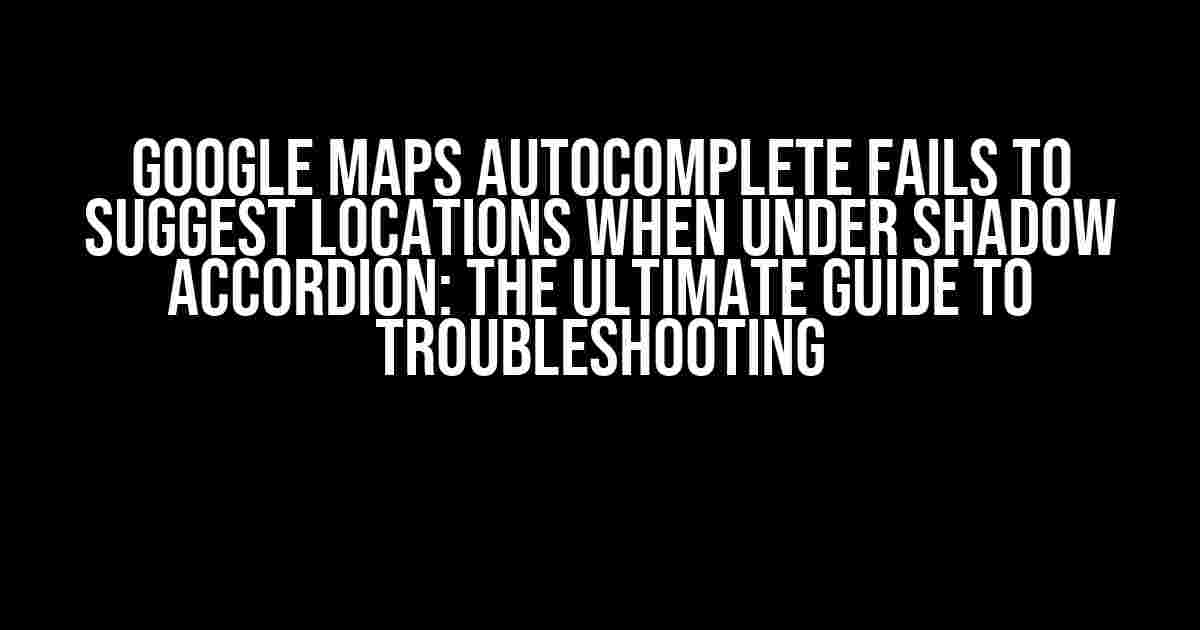Are you tired of seeing blank suggestions when using Google Maps Autocomplete under a Shadow Accordion? You’re not alone! Many developers have encountered this frustrating issue, and today, we’ll dive into the reasons behind it and provide step-by-step solutions to get you back on track.
What is Shadow Accordion?
A Shadow Accordion is a type of UI component that uses the Shadow DOM to create an expandable and collapsible section, allowing users to hide and show content dynamically. While it’s a powerful tool for enhancing user experience, it can sometimes interfere with other JavaScript libraries like Google Maps Autocomplete.
The Issue: Google Maps Autocomplete Failing to Suggest Locations
When implementing Google Maps Autocomplete under a Shadow Accordion, you may notice that the autocomplete suggestions fail to appear, leaving users stranded without any location suggestions. This issue occurs due to the way Shadow Accordion manipulates the DOM, causing Google Maps Autocomplete to lose focus and fail to detect user input.
Understanding the Problem: A Deep Dive into the Code
<shadow-accordion>
<label>Search Location</label>
<input id="autocomplete-input" type="text" placeholder="Enter a location">
</shadow-accordion>
<script>
const autocompleteInput = document.getElementById("autocomplete-input");
const autocomplete = new google.maps.autocomplete(autocompleteInput, {
types: ["geocode"],
});
</script>In the above code snippet, we have a basic Shadow Accordion component with an input field and a Google Maps Autocomplete instance attached to it. However, when the user types into the input field, the autocomplete suggestions won’t appear. Why?
The Solution: Modifying the Shadow Accordion to Work with Google Maps Autocomplete
To resolve this issue, we need to make some adjustments to the Shadow Accordion component and the Google Maps Autocomplete implementation. Follow these steps:
- Update the Shadow Accordion Component: Add the
partattribute to the Shadow Accordion element, allowing it to expose its internal elements to the light DOM. - Use the `attachAutocomplete` Method: Instead of instantiating the Google Maps Autocomplete instance directly, use the
attachAutocompletemethod to attach the autocomplete functionality to the input field. - Set the `autocompleteBounds` Property: Define the boundaries for the autocomplete suggestions by setting the
autocompleteBoundsproperty. This will help Google Maps Autocomplete to provide more accurate suggestions. - Handle the `place_changed` Event: Listen for the
place_changedevent to get the selected place details and update the input field accordingly.
<shadow-accordion part="accordion">
<label>Search Location</label>
<input id="autocomplete-input" type="text" placeholder="Enter a location">
</shadow-accordion><script>
const autocompleteInput = document.getElementById("autocomplete-input");
const autocomplete = google.mapsplaces.AutocompleteService();
autocomplete.attachAutocomplete(autocompleteInput);
</script><script>
autocomplete.setComponentRestrictions({
country: "us",
});
autocomplete.setBounds(new google.maps.LatLngBounds(
new google.maps.LatLng(37.7749, -122.4194), // SW
new google.maps.LatLng(37.8053, -122.4365) // NE
));
</script><script>
autocomplete.addListener("place_changed", () => {
const place = autocomplete.getPlace();
autocompleteInput.value = place.formatted_address;
});
</script>Common Pitfalls to Avoid
When working with Google Maps Autocomplete under a Shadow Accordion, there are some common mistakes to avoid:
- Not setting the `autocompleteBounds` property: Failing to define the autocomplete boundaries can lead to inaccurate or irrelevant suggestions.
- Not using the `attachAutocomplete` method: Directly instantiating the Google Maps Autocomplete instance can cause issues with the Shadow Accordion component.
- Not exposing the internal elements of the Shadow Accordion: Forgetting to add the
partattribute to the Shadow Accordion element can prevent the autocomplete functionality from working correctly.
Best Practices for Implementing Google Maps Autocomplete under Shadow Accordion
To ensure a seamless user experience, follow these best practices when implementing Google Maps Autocomplete under a Shadow Accordion:
| Best Practice | Description |
|---|---|
| Use a clear and concise input field label | Help users understand what they need to type in the input field. |
| Set a clear and relevant placeholder text | Provide a hint to users about the type of input expected. |
| Use a consistent and responsive design | Ensure the Shadow Accordion component and input field adapt to different screen sizes and devices. |
| Implement autocomplete debouncing | Prevent excessive API requests by debouncing the autocomplete functionality. |
| Handle errors and edge cases | Implement error handling and edge case scenarios to provide a robust user experience. |
Conclusion
In conclusion, implementing Google Maps Autocomplete under a Shadow Accordion requires attention to detail and a deep understanding of the underlying technologies. By following the steps and best practices outlined in this article, you’ll be able to create a seamless and intuitive user experience for your users. Remember to stay up-to-date with the latest developments in Google Maps Autocomplete and Shadow Accordion to ensure your implementation remains robust and efficient.
Happy coding!
Here are 5 Questions and Answers about “Google Maps Autocomplete fails to suggest locations when under Shade Accordion” in a creative voice and tone:
Frequently Asked Question
Get the answers to your burning questions about Google Maps Autocomplete and Shade Accordion!
Why does Google Maps Autocomplete fail to suggest locations when under Shade Accordion?
This is likely because the Shade Accordion’s overlay is interfering with Google Maps’ ability to detect the input field, causing the autocomplete feature to malfunction. Try setting the `z-index` of the input field to a higher value than the Shade Accordion’s overlay to resolve this issue!
How do I prevent Google Maps Autocomplete from failing under Shade Accordion?
Easy peasy! Simply set the `z-index` of the input field to a higher value than the Shade Accordion’s overlay, and voilà! Google Maps Autocomplete should start working like a charm again.
Will this issue affect other autocomplete features?
Nope! This issue is specific to Google Maps Autocomplete and Shade Accordion. Other autocomplete features should continue to work as usual, unless they’re also affected by the overlay issue.
Can I report this issue to Google Maps or Shade Accordion developers?
Yes, please do! Reporting this issue to both Google Maps and Shade Accordion developers can help them improve their products and provide a better user experience for everyone. Your feedback is valuable!
Is there a workaround for this issue if I can’t adjust the z-index?
If adjusting the `z-index` isn’t possible, you can try using a different autocomplete library or service that isn’t affected by the Shade Accordion’s overlay. Alternatively, you can also consider using a custom implementation of autocomplete using JavaScript and geocoding APIs.

